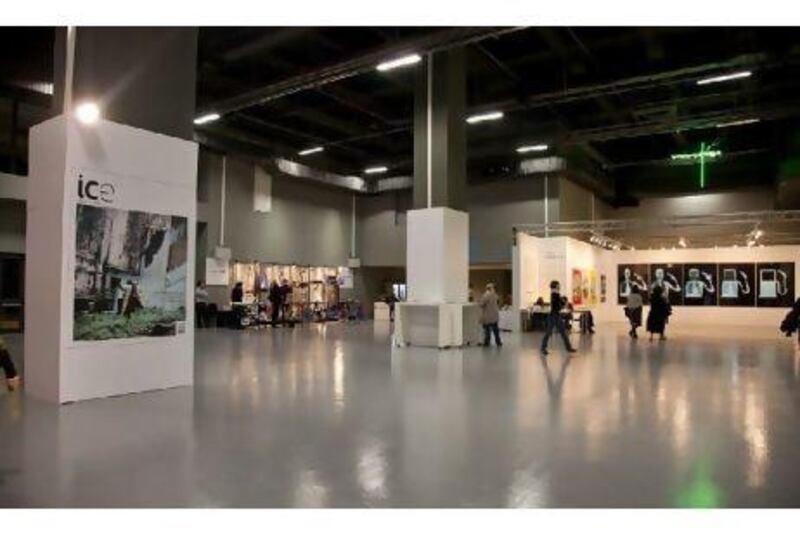The nation's biggest art fair hosts exhibits that appease a hunger for the new, writes Christopher Lord
On the opening night of Contemporary Istanbul, Turkey's biggest art fair, artist Özgür Erkök draped himself in cut-up bin bags and hollered into a microphone atop a Casio keyboard.
The discordant and jarring sound was warped further by speakers unable to deal with the din. Yet around him, a circle of suited, manicured locals formed who, surprisingly, found themselves tapping their foot along.
An enthusiastic response to this abrasive performance really says something about where Turkey's art-going crowd is at. A leaning towards the more experimental and the less conventional mediums of art was obvious at a fair overlooked by two large-scale hips clad only in briefs, an abundance of animations and wacky video shorts and an unabashedly confrontational approach that, according to many of the local and international galleries there to sell, Turkish collectors responded well to.
There was a near 50/50 split of international and Turkish galleries, a balance that plays well on Istanbul's straddling of East and West. Only last year, the event showed a markedly inward-looking market that appeared ambivalent to art coming from abroad. But for its sixth edition, an art-hungry collector base of Turkey's expanding elite seems more open to art from across its borders.
Derya Demir is the founder of Galeri NON, one of the city's most experimental spaces, and had a popular booth at this year's event.
"Collectors are turning into messiahs," she says. "Previously there were collectors who were just buying paintings, and they're now moving into video and editioned artwork. This summer these Turkish collectors also went to the Venice Biennial for the first time, and I had calls from them saying, 'There's an artworld happening! Now we understand what you're talking about.'"
A number of collectors have opened privately funded spaces in Istanbul over the past year to display their acquisitions. Demir explains that without much governmental support for contemporary art, these open-minded buyers are becoming increasingly important for the aspirations of a younger generation of Turkish contemporary artists.
Meanwhile, Spot opened in October and provides a network for collectors in the city, as well as organising discussions, lectures and tours of private collections so that, according to Spot, collectors can "form better informed opinions about the work being created by international and local artists today".
Istanbul's proliferation of DIY art museums - funded by its collecting elite - was initiated, in part, by Can Elgiz in 2001. "There weren't any public spaces or nonprofit exhibitions at that time," he tells The National in his cavernous gallery, Proje4L/Elgiz Museum of Contemporary Art in the city's Levent district. "Our first aim was to show young artists because it's hard to find space in the commercial galleries."
Today, Elgiz displays curated selections from his own collection of western greats alongside major Turkish names, but his acknowledgement of the need for nonprofit spaces has pushed a new generation of collectors into a similar role.
A local hunger for the new, then, was obvious at Contemporary Istanbul, with gallerists seemingly unafraid to present buyers with installations, animations and the visually risqué. Highlights included a wireframe sculpture of a human figure leaning against a wireframe brick wall by Server Demirta, presented by Cagla Cabaogly Gallery from Istanbul. With a hidden internal mechanism, the figure would bang itself against the wall in a show of creaky frustration.
Galeri Nev, another Turkish space, presented bold works by the American photographer Robert Mapplethorpe, including selections from his excellent 1982 series Lisa Lyon, alongside new photographs by Nazif Topcuoglu that show a more dreamlike, impressionistic tone to his work.
One of the most stirring pieces at Contemporary Istanbul this year was an eight-panel work by the Iranian artist Ahmad Morshedloo on Assar Art Gallery's booth from Tehran. Wrought with finesse entirely in ball-point pen, the artist created the scene of a crowd standing before a public hanging. Anonymous legs float into view from above, yet the crowd have their heads down - some appear troubled, others vacant, some even hopeful of a brighter future. But there's one face most disturbing of all - a child, the only one watching what's going on, who stares wildly at the viewer.
This recent work, titled Estrangement, had a huge amount of interest at the fair, says the gallery director Maryam Majd, a returnee of the event. "We can't show this work in Iran, so this is a very good opportunity to have it on the wall. "The collectors here are not just looking into Turkish art any more, so it's much better than last year."
Similarly, the Gulf focus section of the fair also proved successful. Dubai's Green Art Gallery presented and sold editions of a video piece by the Palestinian artist Shadi Habib Allah, while Etemad Gallery, also from Dubai, received solid interest in its roster of Iranian, Chinese and European artists.
"Collectors are understanding that to have a good collection you need to go beyond your comfort zone and explore elsewhere," says Aly Afshar, the director of Etemad.
Carefully curated nonprofit spaces, initiatives designed to educate and the push to get collectors out and engaged with the international art world are all part of an unspoken plan to keep Turkey's art market on solid foundations. This keeps interest steady and burning during boom time, and not easily snuffed out should that change.





